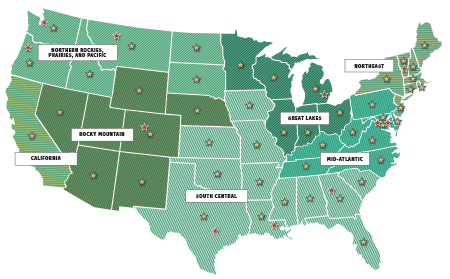Pollinators are the unsung heroes of our gardens, fields, and farms.
Over 100,000 invertebrates—including bees, butterflies, beetles, moths, wasps, and flies—and more than a thousand mammals, birds, reptiles, and amphibians take on the job of pollinating plants. This biodiverse group of wildlife buzzes, flutters, and creeps from plant to plant, dining on protein-rich pollen and high-energy nectar. As they move, they transport and deposit pollen, fertilizing plants and allowing those plants to reproduce.
Bees are the most numerous, effective, and important pollinators. They pollinate both our crops and wild plants, providing us with one-third of the food we eat and allowing wild plants to reproduce and produce the berries, fruits, seeds, and other plant foods that form the base of the natural food web. The domesticated honey bee pollinates the vast majority of agricultural crops. At the same time, roughly 4,000 species of native bees—some of which are endangered—perform the critically important ecological service of pollinating wild plants across all North American ecosystems. Many bees are generalists, but some species are specialized pollinators that require specific host plants to survive. Without healthy habitat, wild bee populations decline and our ecosystems weaken.
Pollinators worldwide are in decline, losing numbers to threats like pesticide poisoning, habitat loss, and disease. The loss of bee populations in particular poses a big risk to both our agricultural system and the ecosystem that supports other wildlife. At the same time, the iconic monarch butterfly has declined by 90 percent in just the last 20 years.
Creating a wildlife habitat garden is one way to help bees and other pollinators at a local level. Plant native blooming trees, shrubs, and wildflowers to provide pollinators with nectar and pollen to eat. Offer water, and don’t spray pesticides. If everyone does their own part in their own yards and communities, the collective benefit to pollinators will be significant.
Take the Clean Earth Challenge and help make the planet a happier, healthier place.
Learn MoreA groundbreaking bipartisan bill aims to address the looming wildlife crisis before it's too late, while creating sorely needed jobs.
Read MoreMore than one-third of U.S. fish and wildlife species are at risk of extinction in the coming decades. We're on the ground in seven regions across the country, collaborating with 52 state and territory affiliates to reverse the crisis and ensure wildlife thrive.
